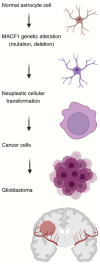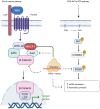Microtubule actin crosslinking factor 1, a brain tumor oncoprotein (Review)
- PMID: 39720461
- PMCID: PMC11667447
- DOI: 10.3892/mco.2024.2810
Microtubule actin crosslinking factor 1, a brain tumor oncoprotein (Review)
Abstract
Microtubule actin crosslinking factor 1 (MACF1), is a cytoskeletal protein that functions as a crosslinker between microtubules and actin filaments, with early studies expanding the role of this spectraplakin protein to the central nervous system and Wnt signaling. In the early 2000's, genetic alterations of MACF1 were identified in several cancers suggesting that this cytoskeletal crosslinker was involved in tumor development and progression, while preclinical studies provided evidence that MACF1 is a potential diagnostic and prognostic biomarker and therapeutic target in glioblastomas, a central nervous system cancer derived from astrocytes and neural progenitor stem cells. Furthermore, investigations in glioblastomas demonstrated that genetic inhibitory targeting of this spectraplakin protein alone and in combination with DNA damaging agents had synergistic antitumorigenic effects. The established role of MACF1 in Wnt signaling, a known mechanistic driver of central nervous system development and pro-tumorigenic cell behavior in glioblastomas, provide a premise for addressing the potential of this spectraplakin protein as a novel oncoprotein in cancers with origins in the nervous system. The present review provides a summary of the role and function of MACF1 in the central nervous system, Wnt signaling and cancer development, specifically as an oncoprotein that underlie the transformation and oncogenic properties of glioblastomas.
Keywords: MACF1; Wnt; astrocytes; cancer; glioblastoma; nervous system; oncoprotein; tumor development.
Copyright: © 2024 Bonner and Quick.
Conflict of interest statement
The authors declare that they have no competing interests.
Figures



Similar articles
-
Inhibition of the Spectraplakin Protein Microtubule Actin Crosslinking Factor 1 Sensitizes Glioblastomas to Radiation.Brain Tumor Res Treat. 2020 Apr;8(1):43-52. doi: 10.14791/btrt.2020.8.e1. Brain Tumor Res Treat. 2020. PMID: 32390353 Free PMC article.
-
Isoforms, structures, and functions of versatile spectraplakin MACF1.BMB Rep. 2016 Jan;49(1):37-44. doi: 10.5483/BMBRep.2016.49.1.185. BMB Rep. 2016. PMID: 26521939 Free PMC article. Review.
-
Microtubule actin cross-linking factor 1, a novel target in glioblastoma.Int J Oncol. 2017 Jan;50(1):310-316. doi: 10.3892/ijo.2016.3798. Epub 2016 Dec 9. Int J Oncol. 2017. PMID: 27959385 Free PMC article.
-
The role of MACF1 in nervous system development and maintenance.Semin Cell Dev Biol. 2017 Sep;69:9-17. doi: 10.1016/j.semcdb.2017.05.020. Epub 2017 Jun 1. Semin Cell Dev Biol. 2017. PMID: 28579452 Free PMC article. Review.
-
Microtubule-Actin Cross-Linking Factor 1: Domains, Interaction Partners, and Tissue-Specific Functions.Methods Enzymol. 2016;569:331-53. doi: 10.1016/bs.mie.2015.05.022. Epub 2015 Jul 14. Methods Enzymol. 2016. PMID: 26778566
References
Publication types
LinkOut - more resources
Full Text Sources
